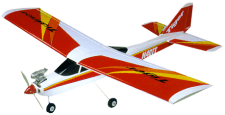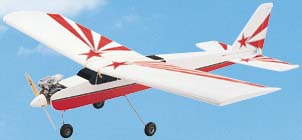First Model
Some people consider a glider as the obvious choice for the first model. Although a glider normally flies slower and is supposed to be more forgiving, I think that's just a matter of taste. Being a skilled glider pilot doesn't necessarily mean being also a skilled powered aircraft pilot and vice-versa.
Assuming that a powered model was chosen, the beginner is advised to start with a so-called trainer. This type is usually a high wing aircraft model with nearly flat bottom airfoil that produces high lift, permitting slow landing speeds without stalling. It also has some dihedral angle to give a good lateral stability.
 However, a flat bottom high wing with dihedral is more sensitive to crosswind gusts, so the first flights should be done during calm weather.
However, a flat bottom high wing with dihedral is more sensitive to crosswind gusts, so the first flights should be done during calm weather.
A beginner should avoid wings with too sharp leading edges, as it will worsen the stall characteristics.
 A well-rounded leading edge is therefore preferable, as it better conveys the airflow onto the upper wing surface allowing higher angle of attack at low speed.
A well-rounded leading edge is therefore preferable, as it better conveys the airflow onto the upper wing surface allowing higher angle of attack at low speed.
A trainer model should not be too small, as it would be difficult to assemble and maintain and would be more sensitive to strong winds.
It should not be too large either, as it would be difficult to transport, require a larger flying field and would be more expensive.
A reasonable size is about 150cm wingspan (60 in) with a high aspect ratio, which means the wingspan being about 5.5 times the wing chord. A square wing is advisable, as it distributes the weight of the aircraft evenly over the entire surface of the wing. In order to allow a reasonable low landing speed without stalling, the wing loading should not be greater than about 60g/sq.dm (19-oz/sq. ft). Wing loading is the aircraft's weight divided by the wing area. Some degree of wing washout also improves the stall characteristics.
